Research on the Mechanism of the Multimodal Sustained Usage of Sport Drones from the Perspective of the Low-Altitude Economy
Abstract
1. Introduction
2. Theoretical Background and Hypotheses
2.1. Theoretical Background
2.2. Hypothetical Model
3. Research Methods
3.1. Sampling Procedure and Data Collection
3.2. Variable Measurement
4. Analysis and Results
4.1. Normality Test
4.2. Evaluation of C-SEM Model
4.2.1. Evaluation of Measurement Model CFA
4.2.2. Evaluation of Structural Model SEM
4.3. Evaluation of BSEM Model
4.3.1. Evaluation of Measurement Model BCFA
4.3.2. Evaluation of Structural Model B-SEM
5. Discussion
5.1. Comparison of Traditional SEM and Bayesian SEM Methods
5.2. Factors Influencing Sustained Usage Intention and Design Strategies for Drone Consumption Services
6. Conclusions
Author Contributions
Funding
Institutional Review Board Statement
Informed Consent Statement
Data Availability Statement
Conflicts of Interest
References
- Liao, W.; Cao, X.; Yuan, L.; Zhong, Z. Context and Progress of Domestic and International Low-Altitude Economic Research Based on the CiteSpace Software. Trop. Geogr. 2025, 45, 937–953. [Google Scholar] [CrossRef]
- Hochstenbach, M.; Notteboom, C.; Theys, B.; De Schutter, J. Design and control of an unmanned aerial vehicle for autonomous parcel delivery with transition from vertical take-off to forward flight-vertikul, a quadcopter tailsitter. Int. J. Micro Air Veh. 2015, 7, 395–405. [Google Scholar] [CrossRef]
- Rasmussen, J.; Ntakos, G.; Nielsen, J.; Svensgaard, J.; Poulsen, R.N.; Christensen, S. Are vegetation indices derived from consumer-grade cameras mounted on UAVs sufficiently reliable for assessing experimental plots? Eur. J. Agron. 2016, 74, 75–92. [Google Scholar] [CrossRef]
- Del-Real, C.; Díaz-Fernández, A.M. Lifeguards in the sky: Examining the public acceptance of beach-rescue drones. Technol. Soc. 2021, 64, 101502. [Google Scholar] [CrossRef]
- Patel, S. Eye in the Sky: Fox Sports Is Bringing Drones to Sporting Events; Digiday: London, UK, 2016. [Google Scholar]
- Russomanno, T.G.; Blauberger, P.; Kolbinger, O.; Lam, H.; Schmid, M.; Lames, M. Drone-based position detection in sports—Validation and applications. Front. Physiol. 2022, 13, 850512. [Google Scholar] [CrossRef]
- Jacobsson, M.; Willén, J.; Mikael, S. A Drone-mounted Depth Camera-based Motion Capture System for Sports Performance Analysis. In Artificial Intelligence in HCI, Proceedings of the 25th International Conference on Human-Computer Interaction (HCII 2023), Copenhagen, Denmark, 23–28 July 2023; Springer Nature: Copenhagen, Denmark; pp. 489–503. [Google Scholar]
- Hebbel-Seeger, A.; Horky, T.; Theobalt, C. Usage of drones in sports communication—New aesthetics and enlargement of space. Athens J. Sports 2017, 4, 89–106. [Google Scholar] [CrossRef]
- Romanowski, A.; Mayer, S.; Lischke, L.; Grudzień, K.; Jaworski, T.; Perenc, I.; Kucharski, P.; Obaid, M.; Kosizski, T.; Wozniak, P.W. Towards supporting remote cheering during running races with drone technology. In Proceedings of the 2017 CHI Conference Extended Abstracts on Human Factors in Computing Systems, Denver, CO, USA, 6–11 May 2017. [Google Scholar]
- Chaitika, K.; Chieh, H.-F.; An, K.-N.; Lin, C.-J.; Su, F.-C. Pei-Wo Drone: A home-based exercise guidance system with a drone for older adults. Sci. Rep. 2025, 15, 10668. [Google Scholar] [CrossRef]
- Eichhorn, C.; Jadid, A.; Plecher, D.A.; Weber, S.; Klinker, G.; Itoh, Y. Catching the drone-a tangible augmented reality game in superhuman sports. In Proceedings of the 2020 IEEE International Symposium on Mixed and Augmented Reality Adjunct (ISMAR-Adjunct), Recife, Brazil, 9–13 November 2020; IEEE: New York, NY, USA, 2020. [Google Scholar]
- Venkatesh, V.; Morris, M.G.; Davis, G.B.; Davis, F.D. User acceptance of information technology: Toward a unified view. MIS Q. 2003, 27, 425–478. [Google Scholar] [CrossRef]
- Aydin, B. Public acceptance of drones: Knowledge, attitudes, and practice. Technol. Soc. 2019, 59, 101180. [Google Scholar] [CrossRef]
- Hinzmann, J.; Bogatzki, K. Acceptance of Autonomous Delivery Vehicles for Last Mile Delivery in Germany: Extension of the Technology Acceptance Model to an Autonomous Delivery Vehicles Acceptance Model. Master’s Thesis, Jönköping University, Jönköping, Sweden, 2020. [Google Scholar]
- Venkatesh, V.; Thong, J.Y.L.; Xu, X. Consumer acceptance and use of information technology: Extending the unified theory of acceptance and use of technology. MIS Q. 2012, 36, 157–178. [Google Scholar] [CrossRef]
- Tsai, P.H.; Tang, J.W.; Ou, M.L. Applying the extended UTAUT-2 to assess the factors contributing to consumers’ usage intention towards over-the-top video streaming platforms. J. Retail. Consum. Serv. 2024, 81, 103995. [Google Scholar] [CrossRef]
- Fischer, P.; Rohrer, U.; Nürnberger, P.; Manninger, M.; Scherr, D.; von Lewinski, D.; Zirlik, A.; Wankmüller, C.; Kolesnik, E. Automated external defibrillator delivery by drone in mountainous regions to support basic life support—A simulation study. Resusc. Plus 2023, 14, 100384. [Google Scholar] [CrossRef] [PubMed]
- Khan, S.I.; Qadir, Z.; Munawar, H.S.; Nayak, S.R.; Budati, A.K.; Verma, K.; Prakash, D. UAVs path planning architecture for effective medical emergency response in future networks. Phys. Commun. 2021, 47, 101337. [Google Scholar] [CrossRef]
- Salmon, P.M.; Macquet, A.-C. Human factors and ergonomics in sport and outdoor recreation: From individuals and their equipment to complex sociotechnical systems and their frailties. Appl. Ergon. 2019, 80, 209–213. [Google Scholar] [CrossRef]
- Kim, K. User Preferences in Drone Design and Operation. Drones 2022, 6, 133. [Google Scholar] [CrossRef]
- Schmidt, S.; Saraceni, A. Consumer acceptance of drone-based technology for last mile delivery. Res. Transp. Econ. 2024, 103, 101404. [Google Scholar] [CrossRef]
- Zhou, M.; Zhao, L.; Kong, N.; Campy, K.S.; Xu, G.; Zhu, G.; Cao, X.; Wang, S. Understanding consumers’ behavior to adopt self-service parcel services for last-mile delivery. J. Retail. Consum. Serv. 2020, 52, 101911. [Google Scholar] [CrossRef]
- Eißfeldt, H.; Vogelpohl, V.; Stolz, M.; Papenfuß, A.; Biella, M.; Belz, J.; Kügler, D. The acceptance of civil drones in Germany. CEAS Aeronaut. J. 2020, 11, 665–676. [Google Scholar] [CrossRef]
- Smith, A.; Dickinson, J.E.; Marsden, G.; Cherrett, T.; Oakey, A.; Grote, M. Public acceptance of the use of drones for logistics: The state of play and moving towards more informed debate. Technol. Soc. 2022, 68, 101883. [Google Scholar] [CrossRef]
- Gupta, A.; Afrin, T.; Scully, E.; Yodo, N. Advances of UAVs toward future transportation: The state-of-the-art, challenges, and opportunities. Future Transp. 2021, 2, 326–350. [Google Scholar] [CrossRef]
- Fehling, C.; Saraceni, A. Technical and legal critical success factors: Feasibility of drones & AGV in the last-mile-delivery. Res. Transp. Bus. Manag. 2023, 50, 101029. [Google Scholar] [CrossRef]
- Shankar, A.; Behl, A.; Pereira, V.; Chavan, M.; Chirico, F. Exploring enablers and inhibitors of AI-enabled drones for manufacturing process audits: A mixed-method approach. Bus. Strategy Environ. 2024, 33, 3749–3768. [Google Scholar] [CrossRef]
- Wang, N.; Mutzner, N.; Blanchet, K. Societal acceptance of urban drones: A scoping literature review. Technol. Soc. 2023, 75, 102377. [Google Scholar] [CrossRef]
- Lee, S.-Y.; Song, X.-Y.; Tang, N.-S. Bayesian methods for analyzing structural equation models with covariates, interaction, and quadratic latent variables. Struct. Equ. Model. A Multidiscip. J. 2007, 14, 404–434. [Google Scholar] [CrossRef]
- Song, X.-Y.; Lee, S.-Y. A tutorial on the Bayesian approach for analyzing structural equation models. J. Math. Psychol. 2012, 56, 135–148. [Google Scholar] [CrossRef]
- Lee, S.-Y.; Song, X.-Y. Evaluation of the Bayesian and maximum likelihood approaches in analyzing structural equation models with small sample sizes. Multivar. Behav. Res. 2004, 39, 653–686. [Google Scholar] [CrossRef]
- Zhao, G.; Wang, Q.; Wu, L.; Dong, Y. Exploring the structural relationship between university support, students’ technostress, and burnout in technology-enhanced learning. Asia Pac. Edu Res. 2022, 31, 463–473. [Google Scholar] [CrossRef]
- Whittaker, T.A.; Schumacker, R.E. A Beginner’s Guide to Structural Equation Modeling, 5th ed.; Routledge: New York, NY, USA, 2022. [Google Scholar]
- Depaoli, S. Measurement and structural model class separation in mixture CFA: ML/EM versus MCMC. Struct. Equ. Model. 2012, 19, 178–203. [Google Scholar] [CrossRef]
- Asparouhov, T.; Muthén, B. Advances in Bayesian Model Fit Evaluation for Structural Equation Models. Struct. Equ. Model. A Multidiscip. J. 2020, 28, 1–14. [Google Scholar] [CrossRef]
- Muthén, L.K.; Muthén, B.O. Mplus User’s Guide, 8th ed.; Muthén & Muthén: Los Angeles, CA, USA, 2017. [Google Scholar]
- Funk, D.C. Introducing a Sport Experience Design (SX) framework for sport consumer behaviour research. Sport Manag. Rev. 2017, 20, 145–158. [Google Scholar] [CrossRef]
- Merkert, R.; Bliemer, M.C.; Fayyaz, M. Consumer preferences for innovative and traditional last-mile parcel delivery. Int. J. Phys. Distrib. Logist. Manag. 2022, 52, 261–284. [Google Scholar] [CrossRef]
- Qian, J.; Zhang, X.; Wang, K.; Liang, J. The role of social-emotional skills in sports participation and mental well-being across different demographics. Learn. Individ. Differ. 2025, 120, 102695. [Google Scholar] [CrossRef]
- Pometko, A.; Dagan, E.; Bertran, F.A.; Isbister, K. Drawing from social media to inspire increasingly playful and social drone futures. In Proceedings of the 2021 ACM Designing Interactive Systems Conference, New York, NY, USA, 28 June–2 July 2021; pp. 697–706. [Google Scholar]
- Lee, D.; Hess, D.J.; Heldeweg, M.A. Safety and privacy regulations for unmanned aerial vehicles: A multiple comparative analysis. Technol. Soc. 2022, 71, 102079. [Google Scholar] [CrossRef]
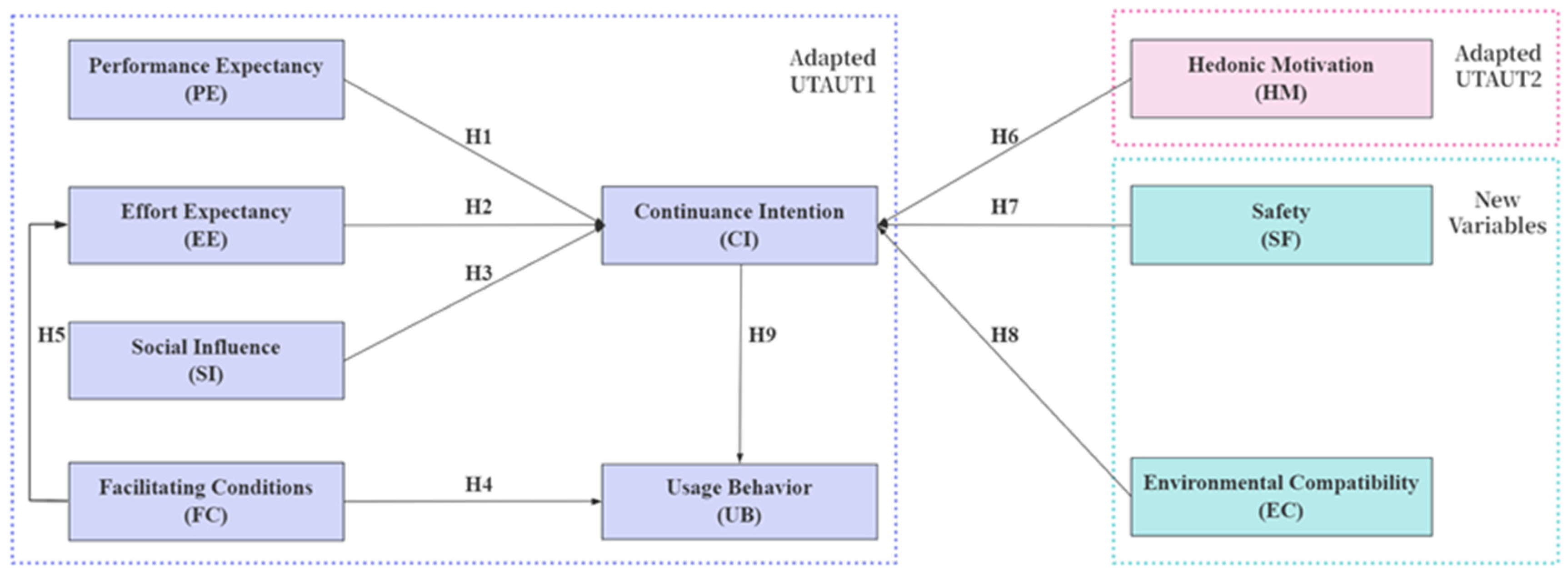
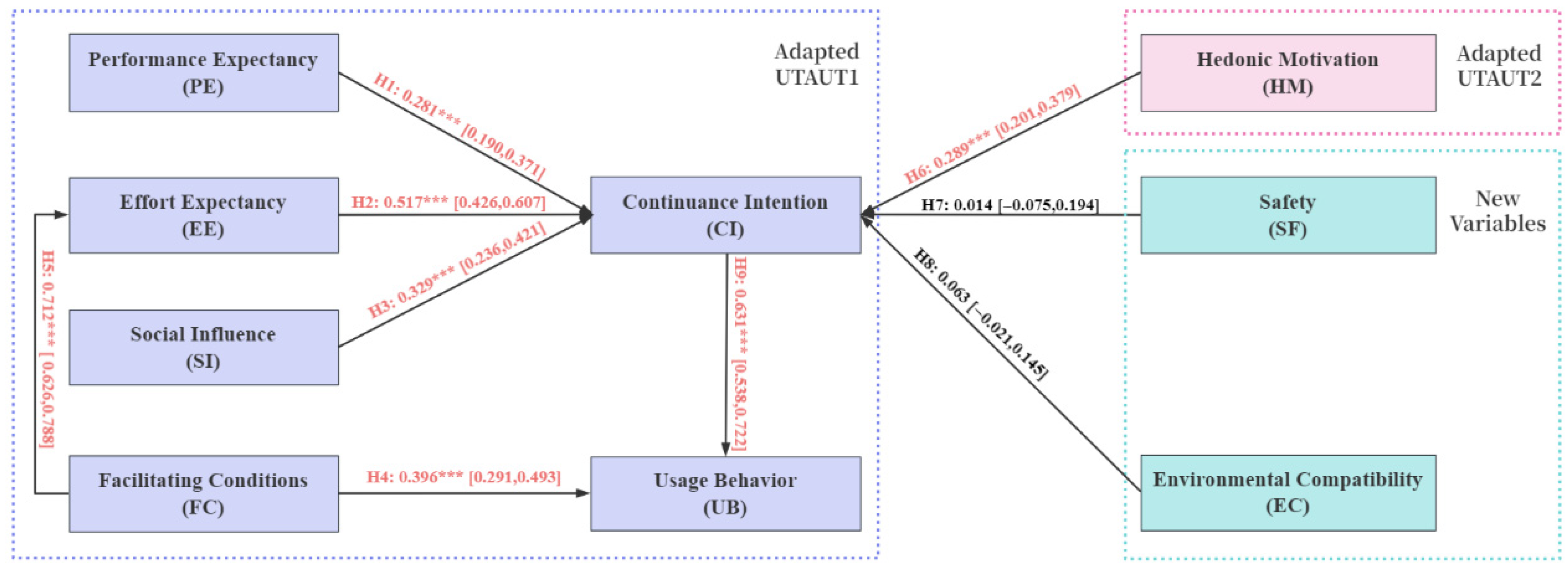
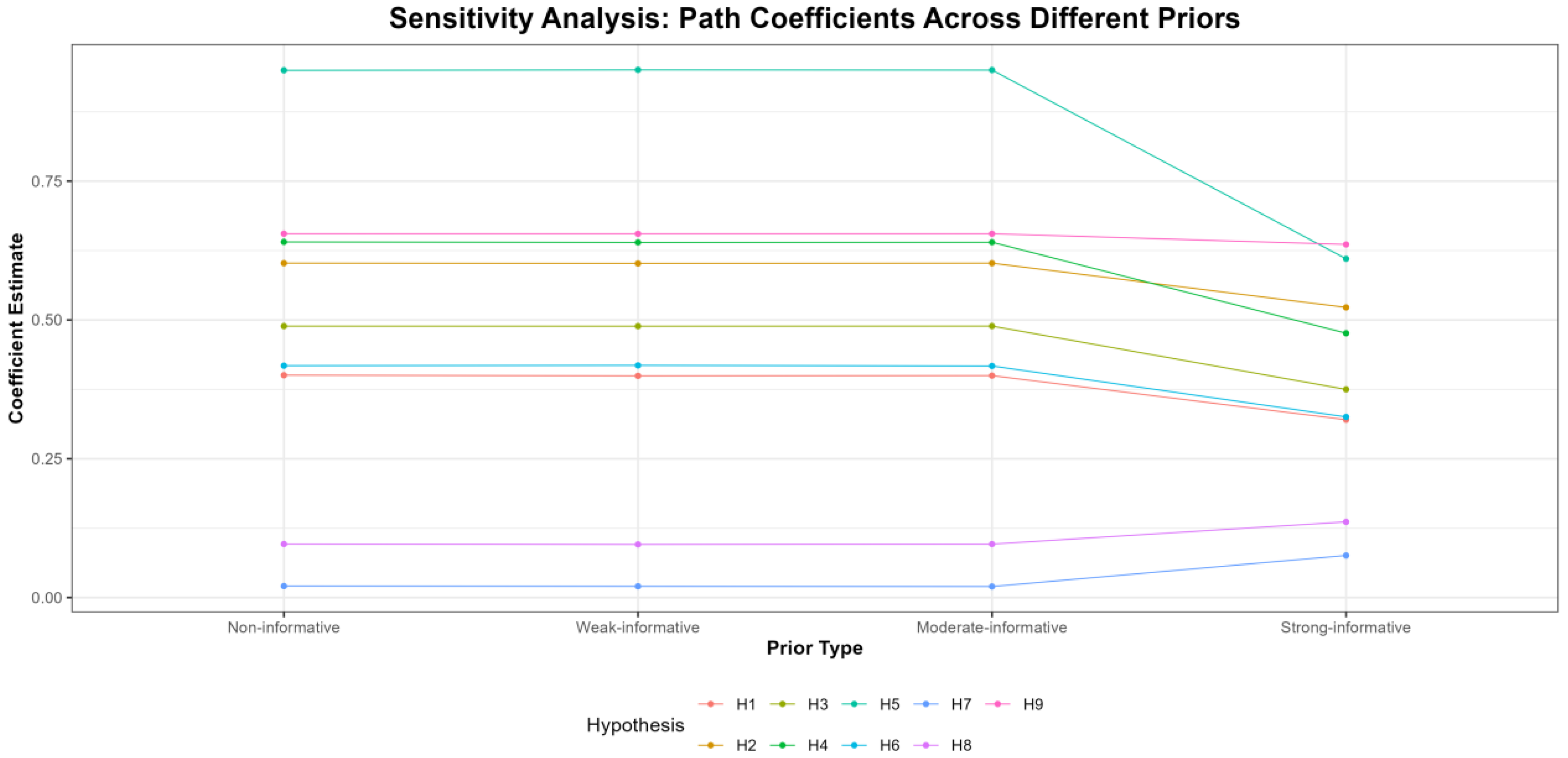

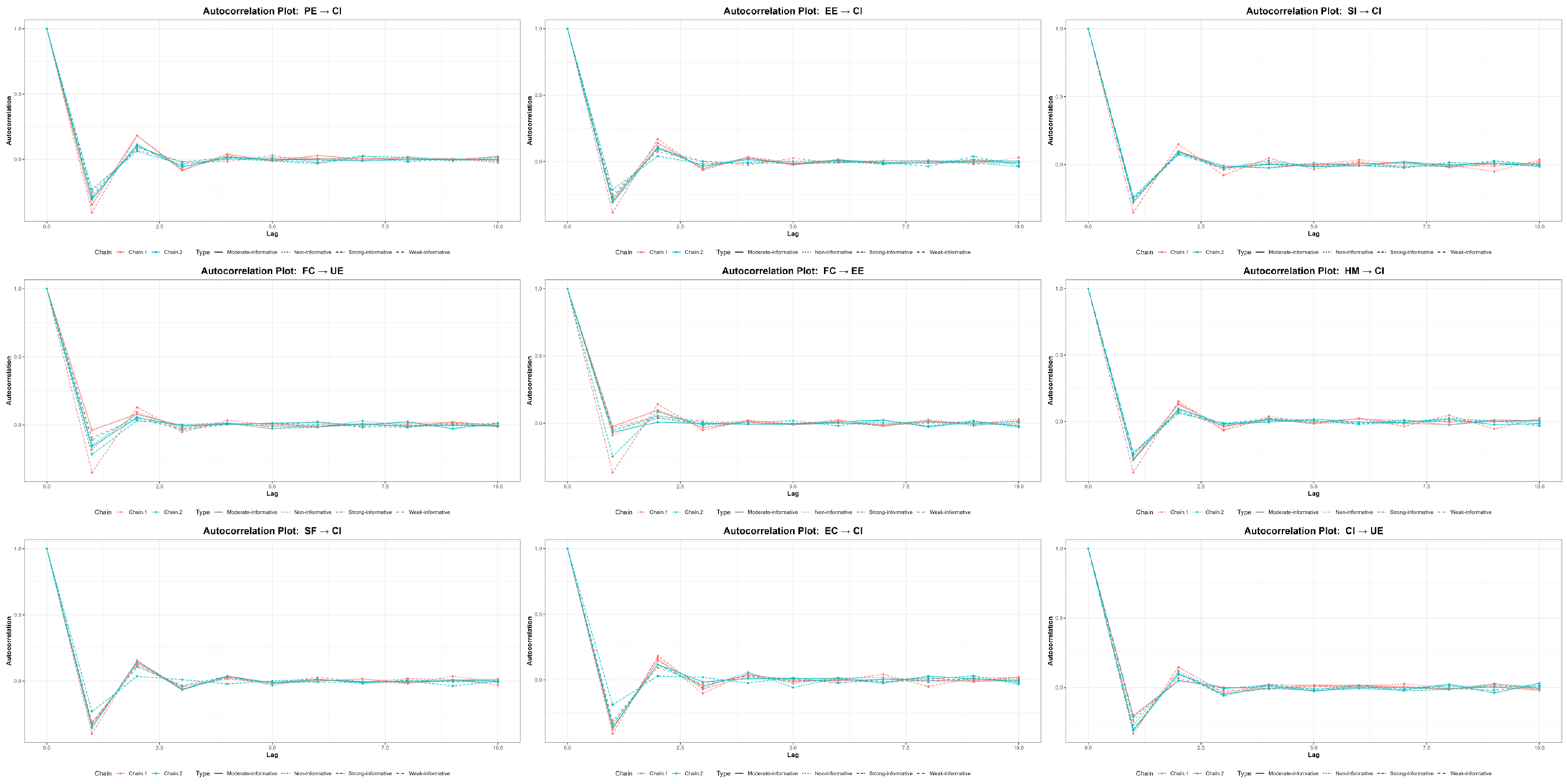
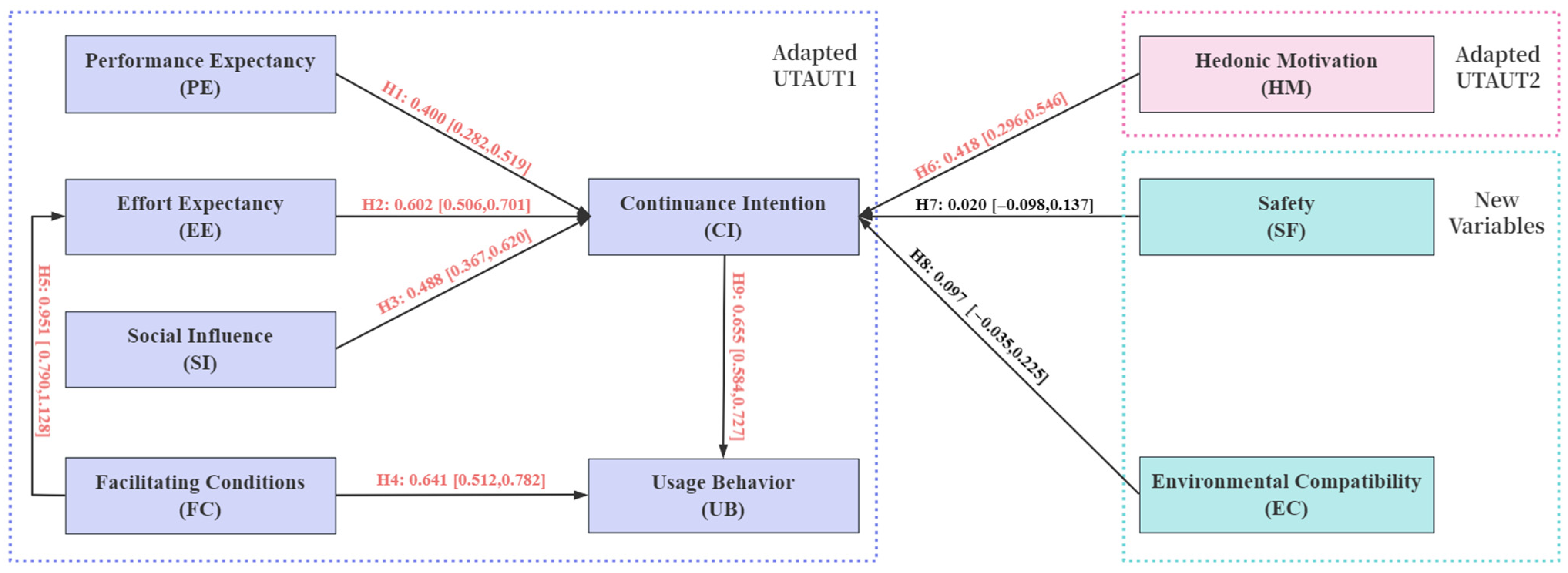
| Construct | Item | Source Adapted | |
|---|---|---|---|
| Performance Expectancy (PE) | PE1 | Using drones can help improve my sports performance. | Venkatesh et al. (2012) [15]; Venkatesh et al. (2003) [12]; |
| PE2 | Using drones significantly enhances my sports performance. | ||
| PE3 | The exercise evaluation function of drones is very important to me. | ||
| Effort Expectancy (EE) | EE1 | I think it will be easy for me to learn how to use drone. | Venkatesh et al. (2012) [15]; Schmidt et al. (2024) [21]; |
| EE2 | I think my interaction with the service via the mobile application will be clear and understandable. | ||
| EE3 | I think it will be easy for me to become skillful at using drone. | ||
| Social Influence (SI) | SI1 | People who are important to me will think that I should use drone. | Venkatesh et al. (2003) [12]; Zhou et al. (2020) [22]; |
| SI2 | People who are important to me will think that I should keep using drones during workouts. | ||
| SI3 | People whose opinion I value will prefer that I use drone. | ||
| Facilitating Conditions (FC) | FC1 | I think I will have the resources necessary to use drone. | Venkatesh et al. (2012) [15]; Venkatesh et al. (2003) [12]; Eißfeldt et al. (2020) [23]; |
| FC2 | I think I will get help from the service provider if I have any difficulty using the drone. | ||
| FC3 | While using drones, any technical issues can be conveniently resolved. | ||
| Hedonic Motivation (HM) | HM1 | Using drone during workouts will be fun. | Schmidt et al. (2024) [21]; Venkatesh et al. (2012) [15]; |
| HM2 | Using drone during workouts will be enjoyable. | ||
| HM3 | Using drone during workouts will be enjoyable entertaining. | ||
| Safety (SF) | SF1 | Drone products will ensure no harm to personnel or property during operation. | Smith et al. (2022) [24]; Gupta et al. (2021) [25]; |
| SF2 | Drone products can better protect users and reduce injury risks. | ||
| SF3 | During unexpected situations, drone products can provide emergency assistance. | ||
| Environmental Compatibility (EC) | EC1 | Drones can operate effectively across diverse environmental conditions. | Fehling et al.(2023) [26]; Shankar et al.(2024) [27]; Wang et al.(2023) [28] |
| EC2 | Drones maintain user experience quality across diverse environments. | ||
| EC3 | I believe drones can adapt to diverse environments to fulfill my needs. | ||
| Continuance Intention (CI) | CI1 | I plan to use drone frequently when available in the future. | Venkatesh et al. (2012) [15]; Venkatesh et al. (2003) [12]; |
| CI2 | I will continue using drone products regularly in the future. | ||
| CI3 | I would recommend drone products to other workout lovers. | ||
| Usage Behavior (UB) | UB1 | I will regularly use drone products during workouts. | Venkatesh et al. (2012) [15]; Venkatesh et al. (2003) [12]; |
| UB2 | I will use drone products to interact during exercise. | ||
| UB3 | I will reuse drone products during workouts and maintain ongoing usage. |
| Category | Items | Frequency | Percentage (%) |
|---|---|---|---|
| Gender | Male | 157 | 52.9% |
| Female | 140 | 47.1% | |
| Age | 18–24 | 218 | 73.4% |
| 25–34 | 31 | 10.4% | |
| 35–44 | 21 | 7.1% | |
| 45–54 | 16 | 5.4% | |
| >55 | 11 | 3.7% | |
| Careers | Student | 157 | 52.9% |
| Self-employed | 34 | 11.4% | |
| Corporate Employee | 63 | 21.2% | |
| Public Employee | 36 | 12.1% | |
| Other | 7 | 2.4% | |
| Exercise frequency per week | 0 | 5 | 1.7% |
| 1–2 | 84 | 28.3% | |
| 3–4 | 103 | 34.7% | |
| 5–6 | 59 | 19.9% | |
| >7 | 46 | 15.5% | |
| Usage period of drone | <1 month | 51 | 17.2% |
| 1–3 months | 45 | 15.2% | |
| 3–6 months | 97 | 32.7% | |
| 6–12 months | 42 | 14.1% | |
| >1 year | 62 | 20.9% | |
| Primary drone applications | Photography | 150 | 50.5% |
| Videography | 149 | 50.2% | |
| Recreational Use | 143 | 48.1% | |
| Sports Analytics | 91 | 30.6% | |
| Other | 5 | 1.7% |
| Construct | Item | Mean | Std. Dev | Skewness | Kurtosis |
|---|---|---|---|---|---|
| PE | PE1 | 3.535 | 1.440 | −0.480 | −1.167 |
| PE2 | 3.138 | 1.521 | −0.102 | −1.453 | |
| PE3 | 3.158 | 1.522 | −0.131 | −1.443 | |
| EE | EE1 | 3.296 | 1.657 | −0.326 | −1.556 |
| EE2 | 3.448 | 1.667 | −0.476 | −1.464 | |
| EE3 | 3.047 | 1.645 | −0.035 | −1.631 | |
| SI | SI1 | 3.562 | 1.501 | −0.532 | −1.205 |
| SI2 | 3.569 | 1.541 | −0.536 | −1.389 | |
| SI3 | 3.367 | 1.541 | −0.357 | −1.389 | |
| FC | FC1 | 3.441 | 1.499 | −0.411 | −1.270 |
| FC2 | 3.098 | 1.538 | −0.103 | −1.467 | |
| FC3 | 3.114 | 1.457 | −0.134 | −1.300 | |
| HM | HM1 | 3.138 | 1.556 | −0.123 | −1.513 |
| HM2 | 3.451 | 1.495 | −0.417 | −1.309 | |
| HM3 | 3.367 | 1.523 | −0.404 | −1.305 | |
| SF | SF1 | 3.512 | 1.522 | −0.512 | −1.228 |
| SF2 | 3.327 | 1.508 | −0.288 | −1.363 | |
| SF3 | 3.428 | 1.607 | −0.412 | −1.449 | |
| EC | EC1 | 3.606 | 1.519 | −0.580 | −1.200 |
| EC2 | 3.306 | 1.552 | −0.291 | −1.445 | |
| EC3 | 3.687 | 1.435 | −0.671 | −0.985 | |
| CI | CI1 | 3.172 | 1.898 | −0.170 | −1.880 |
| CI2 | 3.034 | 1.903 | −0.034 | −1.913 | |
| CI3 | 3.135 | 1.900 | −0.134 | −1.896 | |
| UB | UB1 | 3.141 | 1.916 | −0.139 | −1.908 |
| UB2 | 3.128 | 1.929 | −0.136 | −1.921 | |
| UB3 | 3.141 | 1.894 | −0.150 | −1.881 |
| Construct | Item | Factor Loading | p-Value | SMC | CR | AVE |
|---|---|---|---|---|---|---|
| PE | PE1 | 0.880 | *** | 0.774 | 0.866 | 0.683 |
| PE2 | 0.805 | *** | 0.648 | |||
| PE3 | 0.791 | *** | 0.626 | |||
| EE | EE1 | 0.918 | *** | 0.843 | 0.922 | 0.797 |
| EE2 | 0.867 | *** | 0.752 | |||
| EE3 | 0.892 | *** | 0.796 | |||
| SI | SI1 | 0.799 | *** | 0.638 | 0.864 | 0.679 |
| SI2 | 0.860 | *** | 0.740 | |||
| SI3 | 0.812 | *** | 0.659 | |||
| FC | FC1 | 0.775 | *** | 0.601 | 0.855 | 0.663 |
| FC2 | 0.819 | *** | 0.671 | |||
| FC3 | 0.848 | *** | 0.719 | |||
| HM | HM1 | 0.788 | *** | 0.621 | 0.857 | 0.667 |
| HM2 | 0.837 | *** | 0.701 | |||
| HM3 | 0.824 | *** | 0.679 | |||
| SF | SF1 | 0.841 | *** | 0.707 | 0.851 | 0.657 |
| SF2 | 0.809 | *** | 0.654 | |||
| SF3 | 0.780 | *** | 0.608 | |||
| EC | EC1 | 0.774 | *** | 0.599 | 0.832 | 0.623 |
| EC2 | 0.758 | *** | 0.575 | |||
| EC3 | 0.833 | *** | 0.694 | |||
| CI | CI1 | 0.967 | *** | 0.935 | 0.976 | 0.930 |
| CI2 | 0.971 | *** | 0.943 | |||
| CI3 | 0.955 | *** | 0.912 | |||
| UB | UB1 | 0.982 | *** | 0.964 | 0.984 | 0.954 |
| UB2 | 0.964 | *** | 0.929 | |||
| UB3 | 0.984 | *** | 0.968 |
| PE | EE | SI | FC | HM | SF | EC | CI | UB | |
|---|---|---|---|---|---|---|---|---|---|
| PE | 0.826 | ||||||||
| EE | 0.199 ** | 0.893 | |||||||
| SI | 0.167 * | 0.137 * | 0.824 | ||||||
| FC | 0.010 | 0.688 *** | 0.048 | 0.814 | |||||
| HM | 0.054 | 0.226 *** | 0.107 | 0.205 ** | 0.817 | ||||
| SF | 0.117 * | 0.293 *** | 0.128 | 0.271 *** | 0.242 *** | 0.811 | |||
| EC | 0.218 ** | 0.197 ** | 0.236 *** | 0.238 *** | 0.192 ** | 0.100 | 0.789 | ||
| CI | 0.437 *** | 0.658 *** | 0.472 *** | 0.471 *** | 0.448 *** | 0.294 *** | 0.346 *** | 0.964 *** | |
| UB | 0.343 *** | 0.735 *** | 0.295 *** | 0.677 *** | 0.394 *** | 0.378 *** | 0.306 *** | 0.829 *** | 0.977 *** |
| Model | χ2/df | RMSEA (90%CI) | CFI | TLI | SRMR |
|---|---|---|---|---|---|
| Measurement model | 1.050 | 0.013 (0.000, 0.026) | 0.998 | 0.997 | 0.032 |
| Research model | 1.148 | 0.022 (0.005, 0.033) | 0.993 | 0.992 | 0.046 |
| Recommended criteria | <3.0 | <0.08 | >0.90 | >0.90 | <0.08 |
| Assessment | Good | Good | Good | Good | Good |
| Hypothesis | Path | Estimate | p-Value | 95%CI | Result |
|---|---|---|---|---|---|
| H1 | PE → CI | 0.281 | *** | [0.190, 0.371] | Supported |
| H2 | EE → CI | 0.517 | *** | [0.426, 0.607] | Supported |
| H3 | SI → CI | 0.329 | *** | [0.236, 0.421] | Supported |
| H4 | FC → UB | 0.396 | *** | [0.291, 0.493] | Supported |
| H5 | FC → EE | 0.712 | *** | [0.626, 0.788] | Supported |
| H6 | HM → CI | 0.289 | *** | [0.201, 0.379] | Supported |
| H7 | SF → CI | 0.014 | 0.748 | [−0.075, 0.194] | Not Supported |
| H8 | EC → CI | 0.063 | 0.147 | [−0.021, 0.145] | Not Supported |
| H9 | CI → UB | 0.631 | *** | [0.538, 0.722] | Supported |
| Effect Type | Path | Estimate | S.E. | CS | p-Value | 95%CI | Result |
|---|---|---|---|---|---|---|---|
| Direct Effect | FC → UB | 0.396 | 0.051 | 7.727 | *** | [0.291, 0.493] | YES |
| Indirect Effect | PE → CI → UB | 0.177 | 0.032 | 5.613 | *** | [0.118, 0.240] | YES |
| SI → CI → UB | 0.208 | 0.03 | 6.852 | *** | [0.148, 0.270] | YES | |
| HM → CI → UB | 0.182 | 0.032 | 5.625 | *** | [0.121, 0.248] | YES | |
| SF → CI → UB | 0.009 | 0.028 | 0.319 | 0.749 | [−0.047, 0.062] | NO | |
| EC → CI → UB | 0.04 | 0.027 | 1.45 | 0.147 | [−0.014, 0.091] | NO | |
| EE → CI → UB | 0.326 | 0.04 | 8.157 | *** | [0.251, 0.409] | YES | |
| FC → EE → CI → UB | 0.232 | 0.03 | 7.616 | *** | [0.177, 0.296] | YES | |
| Total Effect | FC → UB (Total) | 0.628 | 0.042 | 14.893 | *** | [0.540, 0.706] | YES |
| PE → UB (Total) | 0.177 | 0.032 | 5.613 | *** | [0.118, 0.240] | YES | |
| SI → UB (Total) | 0.208 | 0.03 | 6.852 | *** | [0.148, 0.270] | YES | |
| HM → UB (Total) | 0.182 | 0.032 | 5.625 | *** | [0.121, 0.248] | YES | |
| SF → UB (Total) | 0.009 | 0.028 | 0.319 | 0.749 | [−0.047, 0.062] | NO | |
| EE → UB (Total) | 0.326 | 0.04 | 8.157 | *** | [0.251, 0.409] | YES | |
| EC → UB (Total) | 0.04 | 0.027 | 1.45 | 0.147 | [−0.014, 0.091] | NO |
| Construct | Item | Factor Loading | Robustness Level | SMC | CR | AVE | Cronbach’s Alpha |
|---|---|---|---|---|---|---|---|
| PE | PE1 | 0.878 | Strong | 0.771 | 0.866 | 0.683 | 0.864 |
| PE2 | 0.800 | Strong | 0.640 | ||||
| PE3 | 0.800 | Strong | 0.640 | ||||
| EE | EE1 | 0.919 | Strong | 0.845 | 0.919 | 0.791 | 0.921 |
| EE2 | 0.866 | Strong | 0.750 | ||||
| EE3 | 0.882 | Strong | 0.778 | ||||
| SI | SI1 | 0.800 | Strong | 0.640 | 0.864 | 0.680 | 0.863 |
| SI2 | 0.861 | Strong | 0.741 | ||||
| SI3 | 0.811 | Strong | 0.658 | ||||
| FC | FC1 | 0.761 | Moderate | 0.579 | 0.852 | 0.658 | 0.854 |
| FC2 | 0.818 | Strong | 0.667 | ||||
| FC3 | 0.852 | Strong | 0.726 | ||||
| HM | HM1 | 0.793 | Moderate | 0.629 | 0.857 | 0.666 | 0.856 |
| HM2 | 0.842 | Strong | 0.709 | ||||
| HM3 | 0.814 | Strong | 0.663 | ||||
| SF | SF1 | 0.835 | Strong | 0.697 | 0.851 | 0.656 | 0.850 |
| SF2 | 0.819 | Strong | 0.671 | ||||
| SF3 | 0.775 | Moderate | 0.601 | ||||
| EC | EC1 | 0.776 | Moderate | 0.602 | 0.832 | 0.623 | 0.830 |
| EC2 | 0.768 | Moderate | 0.590 | ||||
| EC3 | 0.824 | Strong | 0.677 | ||||
| CI | CI1 | 0.967 | Strong | 0.935 | 0.975 | 0.928 | 0.976 |
| CI2 | 0.969 | Strong | 0.939 | ||||
| CI3 | 0.954 | Strong | 0.910 | ||||
| UB | UB1 | 0.979 | Strong | 0.956 | 0.983 | 0.952 | 0.984 |
| UB2 | 0.963 | Strong | 0.927 | ||||
| UB3 | 0.985 | Strong | 0.970 |
| PE | EE | SI | FC | HM | SF | EC | CI | UE | |
|---|---|---|---|---|---|---|---|---|---|
| PE | 0.826 | ||||||||
| EE | 0.178 | 0.889 | |||||||
| SI | 0.151 | 0.115 | 0.825 | ||||||
| FC | −0.030 | 0.661 | 0.030 | 0.811 | |||||
| HM | 0.038 | 0.199 | 0.091 | 0.179 | 0.816 | ||||
| SF | 0.103 | 0.269 | 0.114 | 0.247 | 0.221 | 0.810 | |||
| EC | 0.201 | 0.172 | 0.218 | 0.217 | 0.174 | 0.085 | 0.789 | ||
| CI | 0.420 | 0.633 | 0.454 | 0.439 | 0.426 | 0.268 | 0.322 | 0.963 | |
| UB | 0.324 | 0.712 | 0.274 | 0.652 | 0.369 | 0.355 | 0.280 | 0.813 | 0.976 |
| Model | Fit Indices | ||
|---|---|---|---|
| PPP | BRMSEA (CI) | BCFI (CI) | |
| Measurement Model | 0.000 | 0.249 [0.249, 0.249] | 0.993 [0.990, 0.997] |
| Research Model | 0.528 | 0.023 [0.017, 0.030] | |
| Recommendation Criteria | Close to 0.5 | Maximum value of the confidence interval < 0.06 | Minimum value of the confidence interval >0.95 |
| Assessment | Good | Good | Good |
| BTLI (CI) | BNFI (CI) | PSR | |
| Measurement Model | 0.992 [0.987, 0.996] | 0.956 [0.952, 0.959] | 1.000 |
| Research Model | 1.000 | ||
| Recommendation Criteria | Minimum value of the confidence interval >0.95 | Minimum value of the confidence interval >0.90 | <1.05 |
| Assessment | Good | Good | Good |
| Hypothesis | Path | Estimate | Post SD | 95%CI | Rhat | Result |
|---|---|---|---|---|---|---|
| H1 | PE → CI | 0.400 | 0.061 | [0.282, 0.519] | 1.000 | Supported |
| H2 | EE → CI | 0.602 | 0.050 | [0.506, 0.701] | 1.000 | Supported |
| H3 | SI → CI | 0.488 | 0.064 | [0.367, 0.620] | 1.000 | Supported |
| H4 | FC → UB | 0.641 | 0.069 | [0.512, 0.782] | 1.000 | Supported |
| H5 | FC → EE | 0.951 | 0.087 | [0.790, 1.128] | 1.000 | Supported |
| H6 | HM → CI | 0.418 | 0.064 | [0.296, 0.546] | 1.000 | Supported |
| H7 | SF → CI | 0.020 | 0.060 | [−0.098, 0.137] | 1.000 | Not Supported |
| H8 | EC → CI | 0.097 | 0.065 | [−0.035, 0.225] | 1.000 | Not Supported |
| H9 | CI → UB | 0.655 | 0.037 | [0.584, 0.727] | 1.000 | Supported |
| Effect Type | Path | Estimate | Post SD | CI | Significance |
|---|---|---|---|---|---|
| Direct Effect | FC → UB | 0.641 | 0.069 | [0.506, 0.775] | YES |
| Indirect Effect | PE → CI → UB | 0.262 | 0.042 | [0.180, 0.343] | YES |
| SI → CI → UB | 0.320 | 0.045 | [0.232, 0.408] | YES | |
| HM → CI → UB | 0.274 | 0.045 | [0.186, 0.361] | YES | |
| SF → CI → UB | 0.013 | 0.039 | [−0.063, 0.090] | NO | |
| EC → CI → UB | 0.064 | 0.043 | [−0.021, 0.148] | NO | |
| EE → CI → UB | 0.395 | 0.039 | [0.319, 0.471] | YES | |
| FC → EE → CI → UB | 0.375 | 0.047 | [0.282, 0.468] | YES | |
| Total Effect | PE → UB (Total) | 0.262 | 0.042 | [0.180, 0.343] | YES |
| SI → UB (Total) | 0.320 | 0.045 | [0.232, 0.408] | YES | |
| HM → UB (Total) | 0.274 | 0.045 | [0.186, 0.361] | YES | |
| SF → UB (Total) | 0.013 | 0.039 | [−0.063, 0.090] | NO | |
| EC → UB (Total) | 0.064 | 0.043 | [−0.021, 0.148] | NO | |
| EE → UB (Total) | 0.395 | 0.039 | [0.319, 0.471] | YES | |
| FC → UB (Total) | 1.016 | 0.086 | [0.847, 1.184] | YES |
Disclaimer/Publisher’s Note: The statements, opinions and data contained in all publications are solely those of the individual author(s) and contributor(s) and not of MDPI and/or the editor(s). MDPI and/or the editor(s) disclaim responsibility for any injury to people or property resulting from any ideas, methods, instructions or products referred to in the content. |
© 2025 by the authors. Licensee MDPI, Basel, Switzerland. This article is an open access article distributed under the terms and conditions of the Creative Commons Attribution (CC BY) license (https://creativecommons.org/licenses/by/4.0/).
Share and Cite
Zhang, M.; Zhang, A.; Tian, J.; Deng, B. Research on the Mechanism of the Multimodal Sustained Usage of Sport Drones from the Perspective of the Low-Altitude Economy. Appl. Sci. 2025, 15, 9348. https://doi.org/10.3390/app15179348
Zhang M, Zhang A, Tian J, Deng B. Research on the Mechanism of the Multimodal Sustained Usage of Sport Drones from the Perspective of the Low-Altitude Economy. Applied Sciences. 2025; 15(17):9348. https://doi.org/10.3390/app15179348
Chicago/Turabian StyleZhang, Mengjuan, Aili Zhang, Junxi Tian, and Bo Deng. 2025. "Research on the Mechanism of the Multimodal Sustained Usage of Sport Drones from the Perspective of the Low-Altitude Economy" Applied Sciences 15, no. 17: 9348. https://doi.org/10.3390/app15179348
APA StyleZhang, M., Zhang, A., Tian, J., & Deng, B. (2025). Research on the Mechanism of the Multimodal Sustained Usage of Sport Drones from the Perspective of the Low-Altitude Economy. Applied Sciences, 15(17), 9348. https://doi.org/10.3390/app15179348





